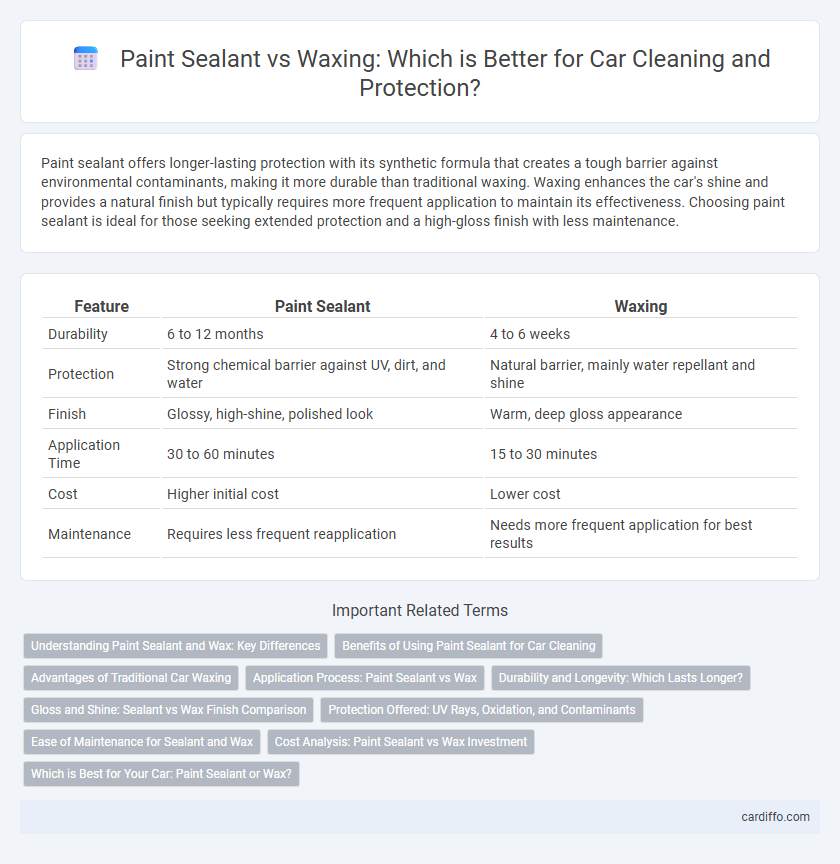Paint sealant offers longer-lasting protection with its synthetic formula that creates a tough barrier against environmental contaminants, making it more durable than traditional waxing. Waxing enhances the car's shine and provides a natural finish but typically requires more frequent application to maintain its effectiveness. Choosing paint sealant is ideal for those seeking extended protection and a high-gloss finish with less maintenance.
Table of Comparison
| Feature | Paint Sealant | Waxing |
|---|---|---|
| Durability | 6 to 12 months | 4 to 6 weeks |
| Protection | Strong chemical barrier against UV, dirt, and water | Natural barrier, mainly water repellant and shine |
| Finish | Glossy, high-shine, polished look | Warm, deep gloss appearance |
| Application Time | 30 to 60 minutes | 15 to 30 minutes |
| Cost | Higher initial cost | Lower cost |
| Maintenance | Requires less frequent reapplication | Needs more frequent application for best results |
Understanding Paint Sealant and Wax: Key Differences
Paint sealant provides a durable, synthetic protective layer that bonds chemically with the vehicle's paint, offering longer-lasting protection against contaminants, UV rays, and oxidation compared to waxing. Waxing involves applying natural or synthetic oils that create a glossy finish and moderate protection but typically requires more frequent reapplication. For enhanced paint preservation, sealants are ideal for extended defense, while waxes contribute superior shine and hydrophobic properties with shorter-term coverage.
Benefits of Using Paint Sealant for Car Cleaning
Paint sealant offers superior durability compared to traditional waxing, providing long-lasting protection against UV rays, oxidation, and environmental contaminants. Its synthetic polymers create a strong, glossy barrier that enhances the car's paint finish while repelling water and dirt more effectively. Using paint sealant reduces the frequency of cleaning and maintenance, preserving the vehicle's appearance and value over time.
Advantages of Traditional Car Waxing
Traditional car waxing offers superior protection by creating a hydrophobic barrier that repels water, dirt, and contaminants, preserving the paint's shine and preventing oxidation. Wax enhances the car's color depth with a rich, glossy finish that emphasizes the vehicle's appearance more naturally than paint sealants. It is easier to apply and remove, making it a preferred choice for car owners seeking regular maintenance without specialized tools or products.
Application Process: Paint Sealant vs Wax
Paint sealant application involves a synthetic polymer formula that bonds chemically to the vehicle's surface, creating a durable, long-lasting protective layer typically applied with an orbital buffer or microfiber applicator. Waxing requires a natural or synthetic wax product applied by hand or machine in thin, even layers, then buffed to a high gloss, providing a temporary barrier against contaminants. Paint sealants generally offer easier maintenance and longer protection, while waxing demands more frequent reapplication to maintain its protective and aesthetic effects.
Durability and Longevity: Which Lasts Longer?
Paint sealants typically offer superior durability and longevity compared to waxing, often lasting between 4 to 6 months due to their advanced synthetic polymers that form a strong protective barrier. Waxing generally provides a glossy finish but tends to last only 4 to 6 weeks since natural waxes degrade faster under environmental exposure. Choosing paint sealant ensures longer-lasting protection against UV rays, contaminants, and oxidation, making it ideal for maintaining vehicle paint over extended periods.
Gloss and Shine: Sealant vs Wax Finish Comparison
Paint sealants provide a longer-lasting, high-gloss finish compared to wax, offering superior protection against environmental contaminants. Sealants form a durable barrier with a synthetic polymer base, maintaining shine for up to six months or more, while waxes typically last a few weeks and deliver a warmer, more natural glow. For intense gloss and enhanced shine retention, paint sealants outperform waxing in both durability and finish quality.
Protection Offered: UV Rays, Oxidation, and Contaminants
Paint sealants provide superior protection against UV rays, oxidation, and environmental contaminants due to their synthetic polymer composition, forming a hard, long-lasting barrier on the vehicle's surface. Waxing offers a natural, glossy finish with moderate protection but tends to break down faster under harsh sunlight and exposure to pollutants. Sealants typically last several months, maintaining the vehicle's appearance and preventing paint fading more effectively than traditional waxes.
Ease of Maintenance for Sealant and Wax
Paint sealants offer longer-lasting protection and require less frequent application, making maintenance easier compared to waxing. Sealants form a hard, durable layer that resists dirt and water, reducing the need for regular cleaning. Waxing, while providing a high-gloss finish, usually demands more frequent reapplication and upkeep to maintain its effectiveness and appearance.
Cost Analysis: Paint Sealant vs Wax Investment
Paint sealant offers longer-lasting protection compared to waxing, typically lasting six to nine months versus wax's four to six weeks, making sealant a more cost-effective choice over time despite its higher upfront price. While waxing generally costs less initially, frequent reapplication expenses add up, increasing overall maintenance costs. Investing in paint sealant reduces the need for repeated treatments, delivering better value and durability for car surface protection.
Which is Best for Your Car: Paint Sealant or Wax?
Paint sealants provide longer-lasting protection and superior durability compared to traditional wax, forming a synthetic barrier that shields your car's paint from UV rays, contaminants, and oxidation for up to six months. Wax offers a natural shine and enhances the gloss of your vehicle but typically lasts only a few weeks and requires more frequent application to maintain its protective qualities. For optimal car care, choose paint sealant for extended protection and durability, while wax is ideal for a glossy finish and short-term enhancement.
Paint sealant vs Waxing Infographic

 cardiffo.com
cardiffo.com